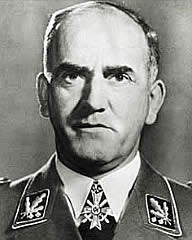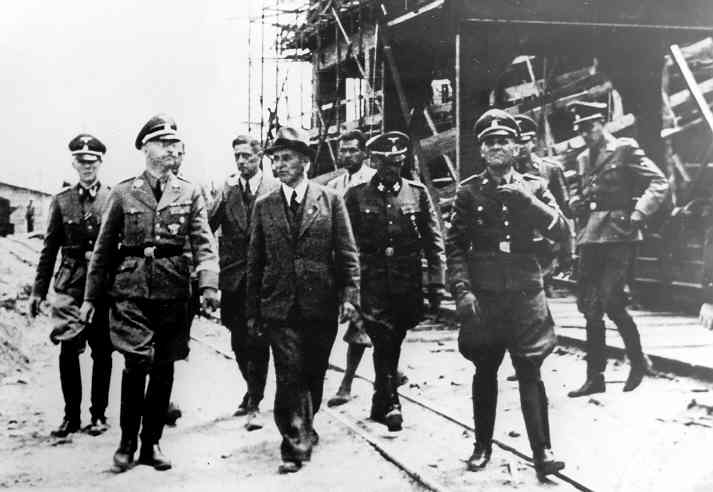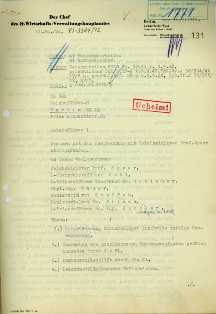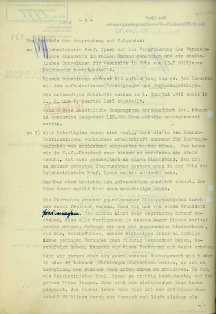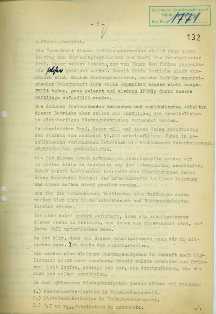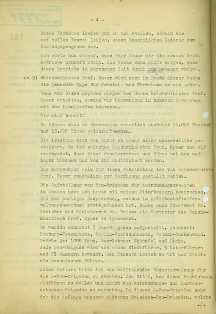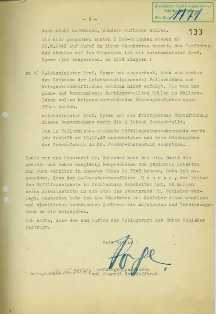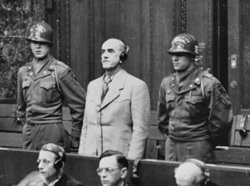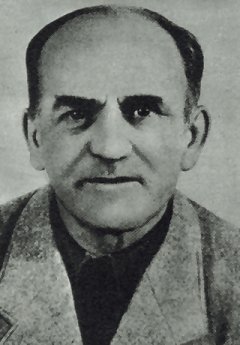Holocaust Education & Archive Research Team |
|
Holocaust Prelude Early Nazi Leaders Nazi Propaganda Nazi Racial Laws Sinti & Roma Kristallnacht The SS SS Leadership Wannsee
Prelude Articles Image Galleries
| ||||
Oswald Pohl
Oswald Pohl was born on June 30 1892, in Duisburg-Ruhrort as the son of blacksmith Hermann Otto Emil Pohl and his wife Auguste Pohl (née Seifert); he was the fifth of a total of eight children. After graduating from school in 1912, he became a full-time soldier in the German navy, being trained in Kiel and Wilhelmshaven as well as the Caribbean and south-east Asia. During World War I, he served at the baltic sea and the coast of Flanders. Pohl also attended a navy school, and became paymaster on April 1, 1918; most of his time in the navy from then on was spent in Kiel. On October 30 the same year, he married.
Pohl also left the church in 1935, and in June 1939 became chief of both the "Hauptamt Verwaltung und Wirtschaft" ("main bureau [for] administration and economy", part of the SS) and the "Hauptamt Haushalt und Bauten" ("main bureau [for] budget and construction", part of the Reich's ministry for the interior). On February 1, 1942, both institutions were combined into the SS-Wirtschafts-Verwaltungshauptamt (SS-WVHA, "SS main bureau for economic administration") with Pohl in charge; among other things, the SS-WVHA was in charge of the organization of the concentration camps, deciding on the distribution of detainees to the various camps and the "rental" of detainees for forced labour until 1944. Pohl was made SS-Obergruppenführer and general of the Waffen-SS on April 20, 1942; on December 12 the same year, after divorce from his wife, he married Eleonore von Brüning, widow of Ernst Rüdiger von Brüning who in turn was the son of one of the founders of the Hoechster Farbwerke which became part of the IG Farben in 1925.
In 1934, the SS was still in its formative stages and its leader, Heinrich Himmler, wanted to fill the SS leadership with a cadre of competent, hard working, and loyal professionals. He noticed Pohl's financial and administrative background in the navy and asked him to join the SS in the position of deputy to the chief of the SS Administrative Office. Pohl, however, was not to remain second-in-command for long. His superior died in February 1934, and Pohl advanced to the top position. At that time, Pohl's office was one of many departments within the SS Main office. The Administrative Office's tasks were restricted to the administration of the Allgemeine SS (General SS). On April 20, 1939, Himmler reorganized the SS Administrative Office and expanded Pohl's responsibilities. The former Administrative Office became a separate SS Main Office responsible for both administrative matters and economic affairs. Himmler also created a Main Office for Budget and Buildings; he put Pohl in charge of both. The overlapping duties of these main offices created bureaucratic confusion. On February 1, 1942, therefore, Himmler ordered another reorganization, and both main offices were fused into one large SS Economic and Administrative Main Office (WVHA) under Pohl's direction.(3)
Click on documents for larger view
Excerpts from a letter from Pohl, Head of the WVHA, to Reichsführer SS Heinrich Himmler regarding a meeting with Reich Minister Albert Speer; Re: war production and bombing damage, 16 September 1942
Because the armament plants came under the jurisdiction of the WVHA's responsibilities for all SS economic affairs, and because these plants required the use of Glueck's concentration camp inmates, there was a great potential for bureaucratic confusion and infighting. Himmler, therefore, ordered yet another reorganization of the WVHA. In March 1942, Himmler put Gluecks' office of the Inspector of Concentration Camps under the authority of Pohl's WVHA.
After the end of World War II in 1945, Pohl first hid in Upper Bavaria, then near Bremen; nevertheless, he was captured by British troops on May 27, 1946. In January 1947, Military Tribunal II, which had been created by the U.S. Military Government for Germany on December 14, 1946, took on the trial of Oswald Pohl and the WVHA, the fourth Subsequent Nuremberg Proceeding. Eighteen defendants, all members of the WVHA (Wirtschaft und Verwaltungshauptamt, the Economic and Administrative Main Office) were indicted on January 13, 1947, and arraigned on March 10. All the defendants were indicted under the first three counts, and all but one under the fourth count. The trial lasted from April 8 until September 22 and the Tribunal delivered its judgment and sentences on November 3. The first count of the indictment (conspiracy) was disregarded and judgments were delivered only on the last three counts. Three of the defendants were acquitted, but the rest were found guilty: two under only the second and third counts and thirteen under the second, third, and fourth counts. The Tribunal sentenced four of the guilty defendants to death, three to life in prison, and eight to prison terms of 10, 20, or 25 years. Seven months later, however, the Military Governor, General Lucius D. Clay, reconvened Military Tribunal II, at the request of the judges, so the defendants could file additional briefs. After hearing more evidence presented on behalf of the defendants, the Tribunal returned its supplemental judgment on August 11, 1948, reaffirming its findings for all the defendants as well as the sentences for all but four.
One of the death sentences was reduced to life imprisonment, one life sentence to 20 years in prison, one 25 year term to 20 years, and one 20 year term to 15 years. The Military Governor confirmed the revised sentences on April 30 and May 11, 1949.
USHMM US NARA Truman Library
Copyright Carmelo Lisciotto H.E.A.R.T 2007
|
